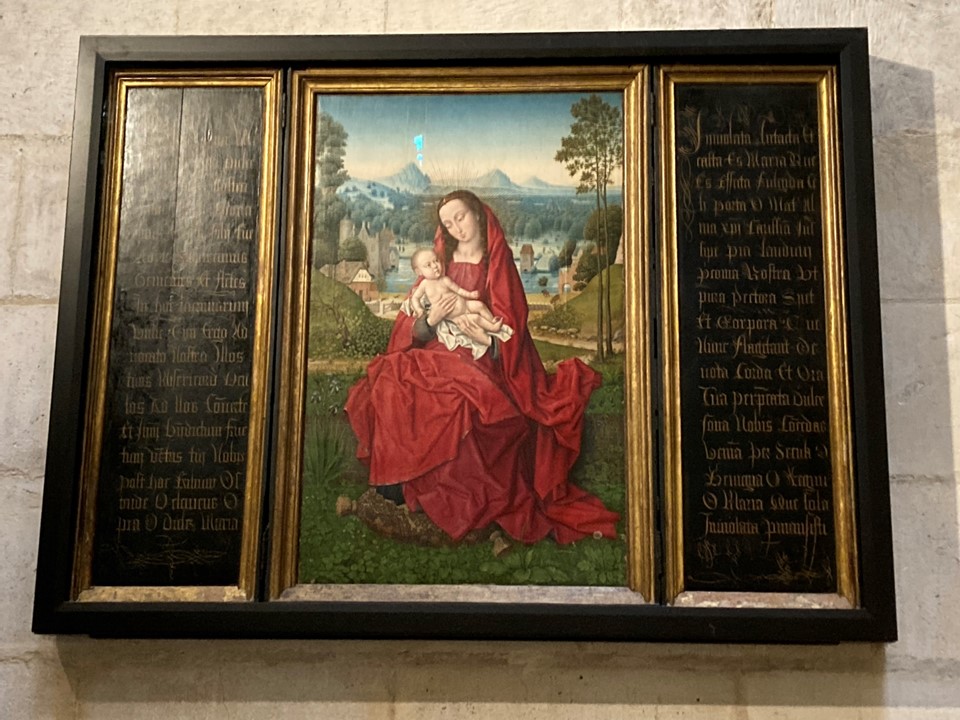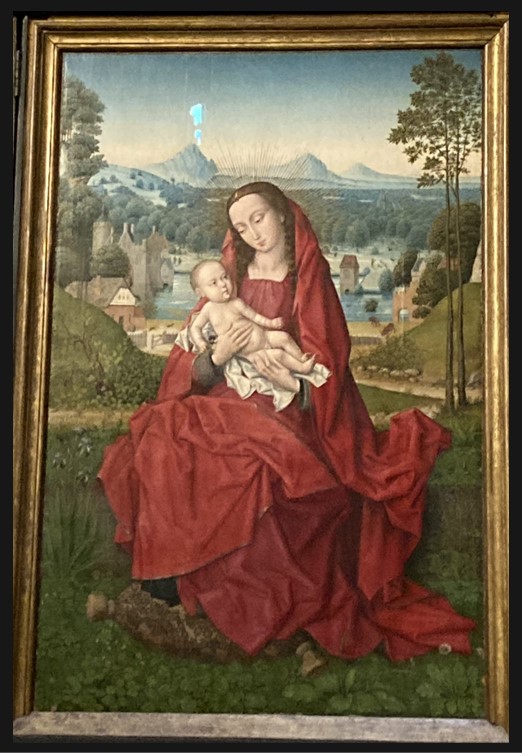
Madonna with Child in a Landscape, c. 1492-1498, Oil on Panel, Burgos Cathedral, Chapel of the Constables, Burgos, Spain – Photo Credit: Amalia Spiliakou, May 14, 2024
On the 14th of May 2024, while visiting the Burgos Cathedral, the Chapel of the Constables to be specific, a beautiful triptych caught my attention. Attributed to the Master of the Madonna Grog, a member of the group of artists formerly associated with the Master of the Embroidered Foliage, the painting of the Madonna with Child in a Landscape stands as a testament to the artistic and spiritual grandeur of the Northern Renaissance period. This exquisite triptych, with its intricate detailing and profound iconography, seamlessly merges the divine serenity of the Madonna and Child theme with the rich, naturalistic backdrop of the landscape. The artwork not only highlights the tender bond between mother and child but also reflects the Renaissance’s burgeoning appreciation for nature and humanism. As a focal point of the Chapel of the Constables, this triptych not only enhances the chapel’s ornate beauty but underscores Burgos Cathedral’s significance as a repository of sacred art and a beacon of devotional artistry.
The Maestro de la Madonna Grog, an enigmatic figure in the annals of art history, is believed to be the artist who created Madonna with Child in a Landscape at the Burgos Cathedral. This serene garden scene presents the Madonna sitting outside with the Child nestled on her lap, surrounded by vibrantly blooming flowers in a verdant, lush landscape. In the background, a river view provides a glimpse of the distinctive architectural style of 15th-century Northern Europe, where the artist likely resided. Clad in a majestic red robe, the Madonna’s face glows with a tender smile as she gently turns to her Child, who holds a small purple flower.
This is no ordinary scene, as the real-world details in the artwork hold deeper religious significance. The ‘gladiolus’ or blue iris, for example, symbolizes the sorrow that pierced Mary’s heart when her son died. This specimen gets its name from the Latin word “gladius,” which means “sword.” The blue violets that Christ holds, on the other hand, symbolize humility, His suffering and sacrifice, spiritual transformation, and the journey towards holiness and grace.

Madonna with Child in a Landscape (central panel), c. 1492-1498, Oil on Panel, Burgos Cathedral, Chapel of the Constables, Burgos, Spain – Photo Credit: Amalia Spiliakou, May 14, 2024
The painting of the Madonna with Child in a Landscape is presented in the Chapel of the Purification, also known as the Constables, in Burgos Cathedral. This chapel, a stunning example of Gothic architecture, is adorned with intricate stone carvings and vibrant stained-glass windows that bathe the space in a kaleidoscope of colours. Constructed in the late 15th century, it serves as a mausoleum for the noble Don Pedro Fernandez de Velasco and his wife, Doña Mencía de Mendoza, whose effigies lie in peaceful repose beneath the soaring vaulted ceiling. The chapel’s grandeur and serene atmosphere provide a fitting backdrop for the Maestro de la Madonna Grog’s masterpiece, enhancing its spiritual and artistic significance within this sacred space.
For a Student Activity, inspired by the Madonna with Child in a Landscape in the Burgos Cathedral, please… Check HERE!